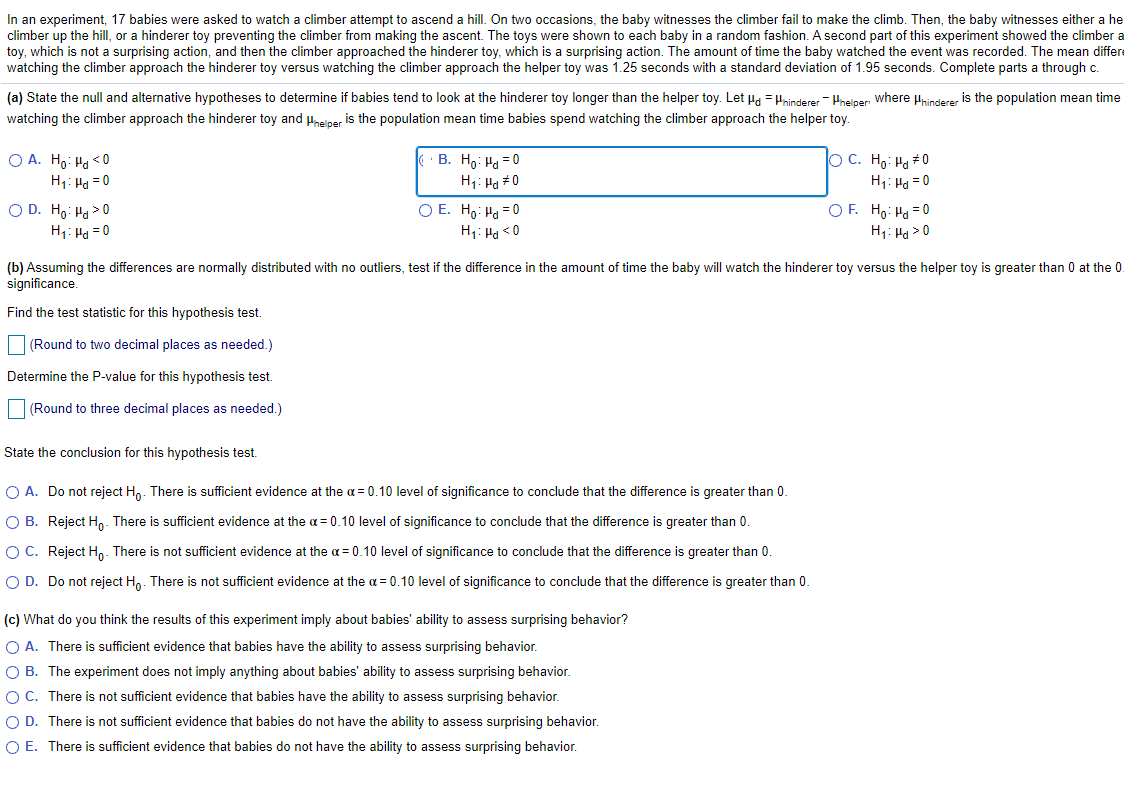In an experiment, 17 babies were asked to watch a climber attempt to ascend a hill. On two occasions, the baby witnesses the climber fail to make the climb. Then, the baby witnesses either a he climber up the hil, or a hinderer toy preventing the climber from making the ascent. The toys were shown to each baby in a random fashion. A second part of this experiment showed the climber a toy, which is not a surprising action, and then the climber approached the hinderer toy, which is a surprising action. The amount of time the baby watched the event was recorded. The mean differ watching the climber approach the hinderer toy versus watching the climber approach the helper toy was 1.25 seconds with a standard deviation of 1.95 seconds. Complete parts a through c. (a) State the null and alternative hypotheses to determine if babies tend to look at the hinderer toy longer than the helper toy. Let Hg = Pninderer - Hneiper where Hninderer is the population mean time watching the climber approach the hinderer toy and Hneloer is the population mean time babies spend watching the climber approach the helper toy. O A. Ho: Ha <0 H1: Ha = 0 E · B. Ho: H = 0 H1: Hg #0 O C. Ho: Hg #0 H,: Ha = 0 O D. Ho: Ha >0 H: Hg = 0 O E. Ho: Ha =0 O F. Ho: Ha =0 H,: Hg > 0 H1: Hg <0 (b) Assuming the differences are normally distributed with no outliers, test if the difference in the amount of time the baby will watch the hinderer toy versus the helper toy is greater than 0 at the C significance. Find the test statistic for this hypothesis test. O(Round to two decimal places as needed.) Determine the P-value for this hypothesis test. O(Round to three decimal places as needed.) State the conclusion for this hypothesis test. O A. Do not reject Ho. There is sufficient evidence at the a = 0.10 level of significance to conclude that the difference is greater than 0. O B. Reject H,. There is sufficient evidence at the a = 0.10 level of significance to conclude that the difference is greater than 0. O C. Reject H. There is not sufficient evidence at the a = 0.10 level of significance to conclude that the difference is greater than 0. O D. Do not reject H,. There is not sufficient evidence at the a = 0.10 level of significance to conclude that the difference is greater than 0. (c) What do you think the results of this experiment imply about babies' ability to assess surprising behavior? O A. There is sufficient evidence that babies have the ability to assess surprising behavior. O B. The experiment does not imply anything about babies' ability to assess surprising behavior. O C. There is not sufficient evidence that babies have the ability to assess surprising behavior. O D. There is not sufficient evidence that babies do not have the ability to assess surprising behavior. O E. There is sufficient evidence that babies do not have the ability to assess surprising behavior.
Addition Rule of Probability
It simply refers to the likelihood of an event taking place whenever the occurrence of an event is uncertain. The probability of a single event can be calculated by dividing the number of successful trials of that event by the total number of trials.
Expected Value
When a large number of trials are performed for any random variable ‘X’, the predicted result is most likely the mean of all the outcomes for the random variable and it is known as expected value also known as expectation. The expected value, also known as the expectation, is denoted by: E(X).
Probability Distributions
Understanding probability is necessary to know the probability distributions. In statistics, probability is how the uncertainty of an event is measured. This event can be anything. The most common examples include tossing a coin, rolling a die, or choosing a card. Each of these events has multiple possibilities. Every such possibility is measured with the help of probability. To be more precise, the probability is used for calculating the occurrence of events that may or may not happen. Probability does not give sure results. Unless the probability of any event is 1, the different outcomes may or may not happen in real life, regardless of how less or how more their probability is.
Basic Probability
The simple definition of probability it is a chance of the occurrence of an event. It is defined in numerical form and the probability value is between 0 to 1. The probability value 0 indicates that there is no chance of that event occurring and the probability value 1 indicates that the event will occur. Sum of the probability value must be 1. The probability value is never a negative number. If it happens, then recheck the calculation.

Trending now
This is a popular solution!
Step by step
Solved in 4 steps







